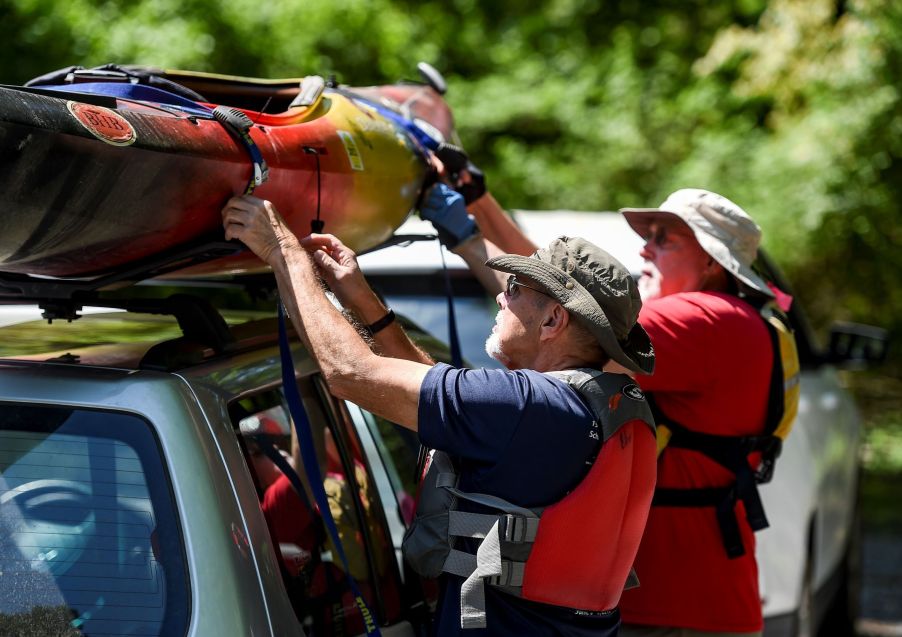
3 Ways to Easily Transport Your Kayak or Canoe
For many, outdoor activities like kayaking and white water rafting are the best part of the spring and summer months. Not only can you explore nature and get a good bit of exercise (unlike with sitting in a boat). You’ll also enjoy either calmness and relaxation or thrills, depending on where your choose to kayak. It’s an activity suited for all ages, and thanks to technology, you can meet up with fellow kayakers wherever you go. However, while kayaking is great fun, driving your kayak from your home or even a rental location to the water is often enough of a hassle that prevents people from kayaking as much as they might otherwise.
Why kayaking and canoeing aren’t the easiest hobbies to have

Folks new to kayaking and canoeing will quickly discover that transporting your newly purchased kayak or canoe can be an ordeal. Not every vehicle, especially older ones, is suited for kayak transport. There are also many kayak and canoe hauling accessories, and it can be difficult to determine which ones are necessary and which aren’t.
Additionally, you also need to determine which accessory brands are quality and which aren’t. After all, the last thing you want to do is reattach a fallen kayak on the shoulder of a highway, or worse yet, have to find a kayak repair shop before your vacation has even started. To this end, you’ll want to be very careful about DIY kayak transport you find online. Many videos with makeshift solutions may save you a few dollars but can be very risky.
You’ll also want to understand the best way to secure different kayaks and canoes, as some can be damaged if secured incorrectly. For example, as per Wave Sport, you want to transport a rotomolded kayak on its edge or hull up. However, a composite watercraft should be transported on its bottom to prevent damage. Kayak and canoe repair can be very expensive, and deformation or degradation in the hull can quickly turn a trip into a nightmare.
How should you transport your kayak or canoe by vehicle?
To get your kayak or canoe from your garage to your destination spot, you should first have roof racks installed. There are two basic racks: roof-mounted rack systems and factory racks. Consisting of four vertical towers and two crossbars, roof-mounted rack systems are very secure and can be used to transport other gear besides just kayaks. Factory roof racks may or may not have crossbars and may require you to purchase a universal mount adapter in addition to the accessories needed to secure your kayak.
In addition to your roof rails, you’ll want to consider one of these options recommended by Erie Insurance:
- J-cradle or V-cradle: A j-cradle or v-cradle is a type of roof rack that can allow you to haul a kayak or canoe on its edge. J-cradles let you haul two at a time. However, it can be difficult for individuals to unload these if they have a long vehicle.
- Saddle rack: These roof racks secure a kayak or canoe hull side up or down. Though you can only transport one at a time, they are easier for individuals to load.
- Foam blocks: If you have regular roof racks, you can buy foam blocks to slide between the rack or roof and the kayak or canoe. Then tie the bow and stem of your kayak down tightly to prevent it from sliding off. While this option will save you some money, it’s best if you only travel a short distance or drive at a low speed.
Other kayak and canoe transportation tips
Hopefully, you’re traveling to your vacation spot when the sun is shining. Still, you’ll want to ensure that your kayak or canoe is placed upside down on your roof to prevent it from filling with water. If you can’t do that, you’ll need to use a portage cover to seal the cockpit. You’ll also want to ensure the straps you’ve used to secure your watercraft have not become slack.
Make sure to inspect your roof rack system for wear and tear periodically. Your rack is consistently exposed to the elements and is not immune to damage. Also, inspect the straps and other accessories you’ll use to attach your kayak or canoe to your SUV or sedan. Before placing an object weighing as much as 100 pounds on top of your vehicle and taking off at 65+ mph, ensure the equipment used to secure it is in good shape.
If you have an older car and have a roof rack installed, find the rack’s load rating. Today’s newer vehicles come with racks that can easily haul equipment that weighs more than the typical kayak or canoe. However, you’ll want to check how much weight a roof rack can carry before buying it to ensure it’s sufficient. Also, look for aerodynamic cross bars to minimize roof rack wind noise and whistling.
Finally, familiarize yourself with how to safely load and unload a small watercraft, especially if you’re a solo traveler. It’s easiest to load a kayak or canoe with two sets of hands, but even then, there are ways to do so that increase the risk of damage. Look online for articles and videos from reputable kayaking and canoeing publications about how to do so easily and safely. A proper roof rack setup won’t mean much if you damage your watercraft by getting it on or off your vehicle.


